

Convair B-36 Variants |

(Download a higher resolution picture by clicking on any
picture below.) 
Wingspan: 230 feetLength: 162 feetWing Area: 4770 square feetMaximum Take-off Weight: 410,000 poundsMaximum Bomb Payload: 2x 42,000 pound Grand Slam bombsPowerplant: 6x 3500 hp R4360 radial engines, 4X 5,200 pound J47-GE-19 turbojets |
XB-36 Prototype |
Excerpt from the Air Force Engineering Division film report: Experimental and Research Aircraft featuring the first flight of the Convair XB-36 42-13570 prototype of the Peacemaker.
Here's a series of still frames from the video:
This panorama was assembled from a sequence of frames in a panning clip. Although the film was exposed in 1946, this panorama did not exist until 2008.
The tip of the vertical stabilizer rises 46 feet, 9 inches above the tarmac.
The tires of the single-wheel main landing gear were nine feet in diameter.
The XB-36 taking off on its first flight from Runway 17 at Fort Worth on August 8, 1946.
The landing gear of the XB-36 remained extended for the duration of the 37-minute flight.
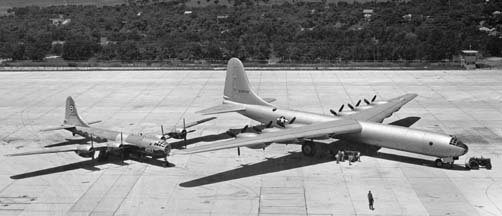 To
emphasize the size of the prototype XB-36 Peacemaker, it was posed
next to the previous superbomber, the Boeing B-29 Superfortress.
Convair photo 10-1796.
To
emphasize the size of the prototype XB-36 Peacemaker, it was posed
next to the previous superbomber, the Boeing B-29 Superfortress.
Convair photo 10-1796.
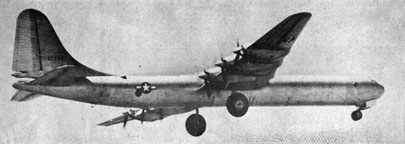 The XB-36 initially had main wheel tires nine feet in diameter. They
were later replaced with four wheel bogies like those on late
production Peacemakers.
The XB-36 initially had main wheel tires nine feet in diameter. They
were later replaced with four wheel bogies like those on late
production Peacemakers.
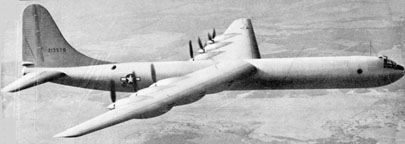 The XB-36
cockpit was stepped in a conventional fashion. The raised
greenhouse canopy was introduced on the YB-36.
The XB-36
cockpit was stepped in a conventional fashion. The raised
greenhouse canopy was introduced on the YB-36.
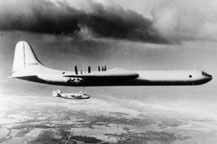 XB-36 with a C-87 transport version
of the Convair Liberator flying chase. Photo courtesy AFFTC/HO.
XB-36 with a C-87 transport version
of the Convair Liberator flying chase. Photo courtesy AFFTC/HO.
 XB-36 in
flight. Convair photo 10-2148.
XB-36 in
flight. Convair photo 10-2148.
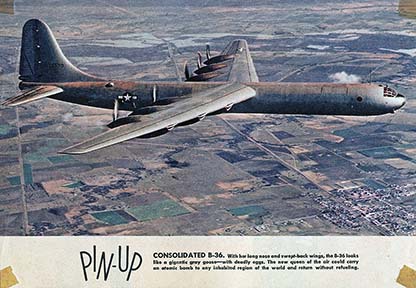 Color photo of the XB-36 in flight.
Color photo of the XB-36 in flight.
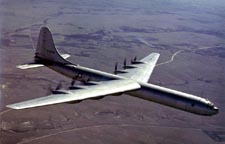 Color photo of the XB-36 in flight.
Color photo of the XB-36 in flight.
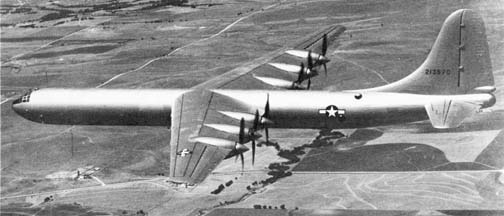 XB-36
photo from an Air Force photo album.
XB-36
photo from an Air Force photo album.
 The propellor of the XB-36 was 19
feet in diameter. Hot air from the manifold was piped through
hollow steel joints for anti-icing.
The propellor of the XB-36 was 19
feet in diameter. Hot air from the manifold was piped through
hollow steel joints for anti-icing.
 This swamp buggy was constructed in 1962 with nine-foot diameter, Goodyear 110 Airplane, 34 Ply tires of the type used on the XB-36. The old tires are in need of replacement. Are there any similarly sized tires available? "It was built from a 3/4 ton truck, has two transmissions and a transfer case, Front transmission has 4 gears, the second has 5 gears plus double reverse, giving you a total of 21 forward gears in low range, and another 21 in high range. For a grand total of 42 forward gears." Photo courtesy Jeffrey Wolfe.
This swamp buggy was constructed in 1962 with nine-foot diameter, Goodyear 110 Airplane, 34 Ply tires of the type used on the XB-36. The old tires are in need of replacement. Are there any similarly sized tires available? "It was built from a 3/4 ton truck, has two transmissions and a transfer case, Front transmission has 4 gears, the second has 5 gears plus double reverse, giving you a total of 21 forward gears in low range, and another 21 in high range. For a grand total of 42 forward gears." Photo courtesy Jeffrey Wolfe.
B-36A Service Test |
 The first B-36A-1-CF, 44-92004
was the second B-36 to fly. It first flew on August 28, 1947,
four months before the YB-36. It made one flight in the vicinity
of the Convair plant at Fort Worth, during which it was
photographed extensively. Two days later it was flown to Wright
Field in Ohio for structural testing. It is seen here on its
flight to Dayton on August 30 with Col. Thomas P. Gerrity and
Beryl Erickson at the controls. Col. Gerrity was one of the Toms
of the Tom-Tom project.
The first B-36A-1-CF, 44-92004
was the second B-36 to fly. It first flew on August 28, 1947,
four months before the YB-36. It made one flight in the vicinity
of the Convair plant at Fort Worth, during which it was
photographed extensively. Two days later it was flown to Wright
Field in Ohio for structural testing. It is seen here on its
flight to Dayton on August 30 with Col. Thomas P. Gerrity and
Beryl Erickson at the controls. Col. Gerrity was one of the Toms
of the Tom-Tom project.
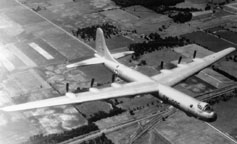 The third B-36A-1-CF, 44-92006
was assigned to service testing at Wright Field. Photo courtesy
AFFTC/HO.
The third B-36A-1-CF, 44-92006
was assigned to service testing at Wright Field. Photo courtesy
AFFTC/HO.
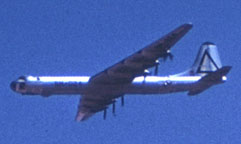 In September 1948, near Sacramento, my father pulled his car off
the road to get a picture of the next to last B-36A-15-CF, 44-92024 as it flew
overhead. The first production model of the B-36 lacked gun
turrets and bombing systems. They were really just huge training
airplanes. Photographer: Richard Lockett, Sr.
In September 1948, near Sacramento, my father pulled his car off
the road to get a picture of the next to last B-36A-15-CF, 44-92024 as it flew
overhead. The first production model of the B-36 lacked gun
turrets and bombing systems. They were really just huge training
airplanes. Photographer: Richard Lockett, Sr.
B-36B Nuclear Bomber |
The B-36B was the first model to be equipped with combat systems.
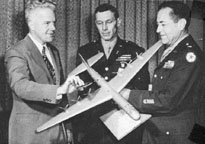 Scale
models of the B-36 and V-2 rocket are examined by Brigadier
General H, Saylor, right, assisted by Dr. R. W. Porter, GE
engineer, while Colonel H. M. Toftoy looks on. Photo was taken
during General Saylor's visit to inspect GE facilities for guided
missiles research. Note the pairs of gun turrets on the forward
and aft fuselage. The cockpit canopy does not exactly resemble
the production unit.
Scale
models of the B-36 and V-2 rocket are examined by Brigadier
General H, Saylor, right, assisted by Dr. R. W. Porter, GE
engineer, while Colonel H. M. Toftoy looks on. Photo was taken
during General Saylor's visit to inspect GE facilities for guided
missiles research. Note the pairs of gun turrets on the forward
and aft fuselage. The cockpit canopy does not exactly resemble
the production unit.
 The
insignia red (FS 36116) tail and wingtips of Convair B-36B,
44-92033 indicate that it is one of 18 B-36s assigned to the GEM
program. The GEM program investigated the operation of the B-36
in the extremely cold conditions of the forward bases at Goose
Bay, Labrador, Limestone, Maine, and Fairbanks, Alaska. The large
red surfaces were intended to make the airplane easier to find if
it went down on ice or snow in arctic regions.
The
insignia red (FS 36116) tail and wingtips of Convair B-36B,
44-92033 indicate that it is one of 18 B-36s assigned to the GEM
program. The GEM program investigated the operation of the B-36
in the extremely cold conditions of the forward bases at Goose
Bay, Labrador, Limestone, Maine, and Fairbanks, Alaska. The large
red surfaces were intended to make the airplane easier to find if
it went down on ice or snow in arctic regions.
 This
photograph of Convair B-36B 44-92033 may have been taken with a
red filter to make the red areas on the wingtip and tail appear
so bright in comparison to other pictures of GEM B-36s that
appear below.
This
photograph of Convair B-36B 44-92033 may have been taken with a
red filter to make the red areas on the wingtip and tail appear
so bright in comparison to other pictures of GEM B-36s that
appear below.
 The fourth B-36B-1-CF, 44-92029
crashed at Carswell AFB on February 8, 1955. It was knocked down
by windshear while practicing landings. Photo courtesy AFFTC/HO.
The fourth B-36B-1-CF, 44-92029
crashed at Carswell AFB on February 8, 1955. It was knocked down
by windshear while practicing landings. Photo courtesy AFFTC/HO.
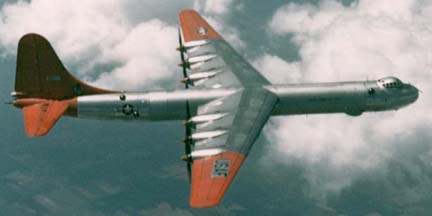 B-36B
heading to a flyover of Chicago on July 3, 1949. The bulges
visible on the top of the wing inboard of the engine nacelles
were added to make room for the four-wheeled main landing gear.
Photographer: Frank Kleinwechter, former 7th Bomb Group B-36 crew
member.
B-36B
heading to a flyover of Chicago on July 3, 1949. The bulges
visible on the top of the wing inboard of the engine nacelles
were added to make room for the four-wheeled main landing gear.
Photographer: Frank Kleinwechter, former 7th Bomb Group B-36 crew
member.
 Storm clouds loom over Carswell AFB flightline in 1949.
Photographer: Frank Kleinwechter, former 7th Bomb Group B-36 crew
member.
Storm clouds loom over Carswell AFB flightline in 1949.
Photographer: Frank Kleinwechter, former 7th Bomb Group B-36 crew
member.
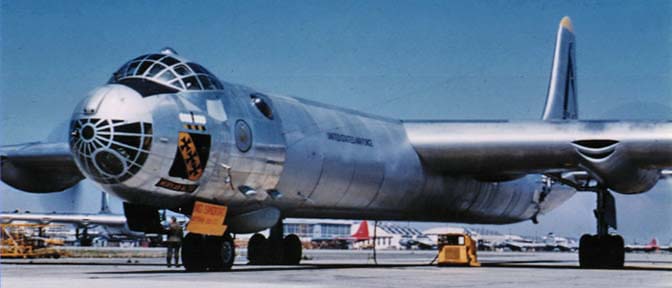 B-36B of the 7th Bomb Group runs up
its engines while visiting Fairfield-Suisun
Air Force Base (now Travis AFB) on May 14, 1950.
Photographer: Frank Kleinwechter, former 7th Bomb Group B-36 crew
member.
B-36B of the 7th Bomb Group runs up
its engines while visiting Fairfield-Suisun
Air Force Base (now Travis AFB) on May 14, 1950.
Photographer: Frank Kleinwechter, former 7th Bomb Group B-36 crew
member.
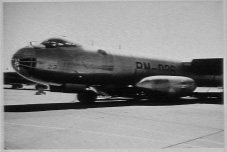 B-36B-1-CF, serial 44-92036, which has been modified with a pair
of large pods on either side of the fuselage. Frame 22854 of National Air and
Space Museum Archival Videodisc #1.
B-36B-1-CF, serial 44-92036, which has been modified with a pair
of large pods on either side of the fuselage. Frame 22854 of National Air and
Space Museum Archival Videodisc #1.
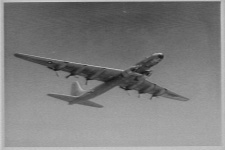 The pods were used to carry extra built-up R-4360 radial engines
to deployment bases. Frame 22774
of National Air and Space Museum Archival Videodisc #1.
The pods were used to carry extra built-up R-4360 radial engines
to deployment bases. Frame 22774
of National Air and Space Museum Archival Videodisc #1.
B-36 Nuclear Bomber |
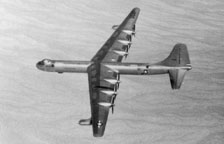 Two pairs of J-47 jet engines were
introduced on the D-model of the B-36. Photo courtesy
AFFTC/HO.
Two pairs of J-47 jet engines were
introduced on the D-model of the B-36. Photo courtesy
AFFTC/HO.
 B-36F-5-CF
49-2683 on the old South Base flightline of Edwards Air Force
Base. Behind it to the right are a Boeing C-97 Stratocruiser and
B-47 Stratojet. On the left is an RB-36. Note the difference in
the placement of the bomb bay doors on the RB-36. Rogers Dry Lake
can be seen in the background. Photo courtesy AFFTC/HO.
B-36F-5-CF
49-2683 on the old South Base flightline of Edwards Air Force
Base. Behind it to the right are a Boeing C-97 Stratocruiser and
B-47 Stratojet. On the left is an RB-36. Note the difference in
the placement of the bomb bay doors on the RB-36. Rogers Dry Lake
can be seen in the background. Photo courtesy AFFTC/HO.
 Featherweight B-36
has no nose turret. It is parked on the Edwards Air Force Base
flightline. In the background is a modified B-29 Superfortress, a
B-52A Stratofortress, B-47 Stratojets and F-100 Super Sabres.
Featherweight B-36
has no nose turret. It is parked on the Edwards Air Force Base
flightline. In the background is a modified B-29 Superfortress, a
B-52A Stratofortress, B-47 Stratojets and F-100 Super Sabres.
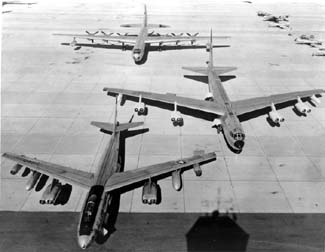 Convair B-36, Boeing B-52B and
B-47E at Eglin AFB firepower demonstration.
Convair B-36, Boeing B-52B and
B-47E at Eglin AFB firepower demonstration.
RB-36 Reconnaissance Bomber |
In the early 1950s, the RB-36 was one of the primary intelligence gathering airplanes in the Air Force inventory. Where standard B-36 bombers had four bomb bays, the forward bomb bay of the RB-36 was converted to a pressurized camera compartment. The camera compartment was connected to the forward crew compartment by a tunnel through the turret bay and to the aft crew compartment by a tunnel through the bomb bays. The RB-36 was typically equipped with fourteen cameras with focal lengths up to 1200 mm. They used film that was up to 9 inches by 18 inches.
The pressurized sections of the B-36 were skinned with aluminum. The bomb bay and the gun turret bays were skinned with magnesium. RB-36s can be spotted by the shinier aluminum camera compartment with a pair of windows in front of the wing.
 RB-36D-1 44-92088 was ordered from Consolidated-Vultee as a B-36B bomber without jet engine pods. Before it was built, the order was converted to build it as an RB-36D. It was the first RB-36D to come off the assembly line with the camera compartment already installed. It made its first flight without jet engine pods on December 18, 1949. Jet engine pods were installed on 44-92088 in early 1950. It made a demonstration flight for President Truman at Eglin Air Force Base, Florida on April 22, 1950. Later, 44-92088 tested the Boston camera, which used 18" x 36" film. It had a 240" (6,000 mm) focal length. Photo courtesy Kathy (Dragoo) Matelski.
RB-36D-1 44-92088 was ordered from Consolidated-Vultee as a B-36B bomber without jet engine pods. Before it was built, the order was converted to build it as an RB-36D. It was the first RB-36D to come off the assembly line with the camera compartment already installed. It made its first flight without jet engine pods on December 18, 1949. Jet engine pods were installed on 44-92088 in early 1950. It made a demonstration flight for President Truman at Eglin Air Force Base, Florida on April 22, 1950. Later, 44-92088 tested the Boston camera, which used 18" x 36" film. It had a 240" (6,000 mm) focal length. Photo courtesy Kathy (Dragoo) Matelski.
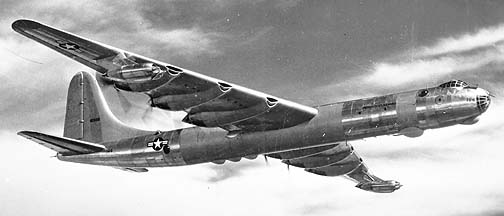 RB-36D-10-CF
49-2688. Note the three electronics intelligence antennae
under the fourth bomb bay. Courtesy Air Force Flight Test Center History Office.
RB-36D-10-CF
49-2688. Note the three electronics intelligence antennae
under the fourth bomb bay. Courtesy Air Force Flight Test Center History Office.
 RB-36F-1-CF 49-2708
of the 99th Strategic Reconnaissance Wing on the ramp at
Fairchild AFB. Photo courtesy Fairchild Air Force Base Heritage
Museum.
RB-36F-1-CF 49-2708
of the 99th Strategic Reconnaissance Wing on the ramp at
Fairchild AFB. Photo courtesy Fairchild Air Force Base Heritage
Museum.
This picture shows the original bomb bay configuration of the RB-36F. The aft bomb bay was sealed and electronics intelligence equipment was housed in the space. Three electronics intelligence antennea were housed in radomes mounted on the underside of the bay. Photo flash bombs were housed in the second bomb bay and an extra fuel tank was installed in the third bomb bay. The second and third bays were equipped with a single pair of doors.
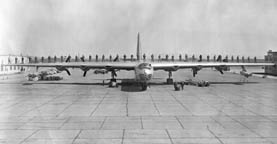 RB-36
of the 99SRW (H) at Fairchild Air Force Base in 1953. Photo
courtesy Don Gasvoda, former 99th A & E Q-24
Radar/Bomb computer mechanic.
RB-36
of the 99SRW (H) at Fairchild Air Force Base in 1953. Photo
courtesy Don Gasvoda, former 99th A & E Q-24
Radar/Bomb computer mechanic.
In June 1954, the primary role of the RB-36 fleet was changed to heavy bombardment. Technical Order 1B-36(R)-216 directed that the aft bomb bay should be converted to a functional bomb bay. The electronics intelligence gear and antennae were moved to the aft crew compartment. A short pair of doors covered the second bomb bay. The third and fourth bomb bays were equippped with a single pair of doors.
 RB-36F-1-CF 49-2709 at
Fairchild Air Force Base on August 28, 1956. The 99th has become
a Heavy Bombardment Wing. RB-36F 49-2709 has had white anti-flash
paint added to its undersides. The electronics intelligance
antennae have been moved aft in accordance with Technical Order
1B-36(R)-216. Photo courtesy Fairchild Air Force Base Heritage
Museum.
RB-36F-1-CF 49-2709 at
Fairchild Air Force Base on August 28, 1956. The 99th has become
a Heavy Bombardment Wing. RB-36F 49-2709 has had white anti-flash
paint added to its undersides. The electronics intelligance
antennae have been moved aft in accordance with Technical Order
1B-36(R)-216. Photo courtesy Fairchild Air Force Base Heritage
Museum.
In the foreground is the pit that was used to load Republic RF-84K Thunderflashes into GRB-36D carrier airplanes of the Fighter Conveyer (FICON) squadron. FICON operatoins had been suspended in January 1956. The wedges served as permanent wheel chocks
GRB-36D Aircraft Carrier |
 From 1952 to 1956, the Project FICON investigated the potential of carrying various models of the Republic F-84 in the bomb bay of a Peacemaker to perform reconnaissance missions into areas that were too heavily defended for the RB-36 to penetrate.
From 1952 to 1956, the Project FICON investigated the potential of carrying various models of the Republic F-84 in the bomb bay of a Peacemaker to perform reconnaissance missions into areas that were too heavily defended for the RB-36 to penetrate.
NB-36H Flying Nuclear Testbed |
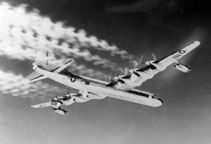 The "Convair Crusader" NB-36H, 51-5712 was
equipped with a functioning air-cooled nuclear reactor and a lead
shielded crew compartment. The reactor did not power the
airplane. Tests were conducted to determine the effects of
radiation on instrumentation and equipment.
The "Convair Crusader" NB-36H, 51-5712 was
equipped with a functioning air-cooled nuclear reactor and a lead
shielded crew compartment. The reactor did not power the
airplane. Tests were conducted to determine the effects of
radiation on instrumentation and equipment.
Convair YB-60Wingspan: 206 feetLength: 171 feetWing Area: 5,239 square feetMaximum Take-off Weight: 410,000 poundsMaximum Bomb Payload: 72,000 poundsPowerplant: 8x 8,700 pound J57-P-3 turbojets |
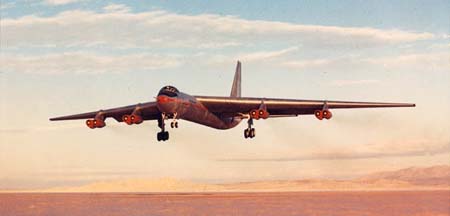 The YB-60 page
shows the all-jet competitor to the Boeing B-52 Stratofortress.
The YB-60 page
shows the all-jet competitor to the Boeing B-52 Stratofortress.
B-36 Collectibles |
 The Yonezawa Company of Japan
manufactured this Convair B-36 tin litho toy. The friction drive
is connected to all six propellers, and it has a wingspan of 26
inches.
The Yonezawa Company of Japan
manufactured this Convair B-36 tin litho toy. The friction drive
is connected to all six propellers, and it has a wingspan of 26
inches.
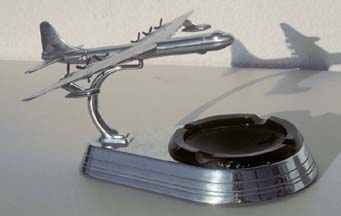 This Convair B-36 ashtray was manufactured by the Allyn Sales
Company of Los Angeles.
This Convair B-36 ashtray was manufactured by the Allyn Sales
Company of Los Angeles.
Radio-controlled B-36 Models |
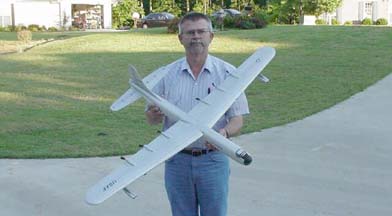 Gary Jones' electric powered B-36 model. It
flew indoors at the Southwest Aeromodeling Conference in
Arlington, TX on May 18 and 19, 2001. The airplane weighs less
than 13 ounces, ready to fly. Its wingspan is 51.5 inches. It is
constructed mainly of styrofoam. The jet engines were carved from
balsa wood.
Gary Jones' electric powered B-36 model. It
flew indoors at the Southwest Aeromodeling Conference in
Arlington, TX on May 18 and 19, 2001. The airplane weighs less
than 13 ounces, ready to fly. Its wingspan is 51.5 inches. It is
constructed mainly of styrofoam. The jet engines were carved from
balsa wood.
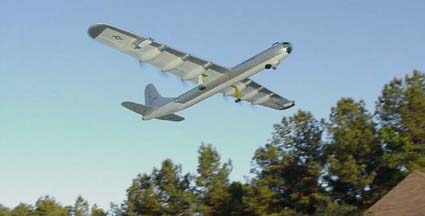 Gary Jones' electric powered B-36 model in
flight. These pictures were taken by Gary's brother, Clevis
Jones, Jr.
Gary Jones' electric powered B-36 model in
flight. These pictures were taken by Gary's brother, Clevis
Jones, Jr.
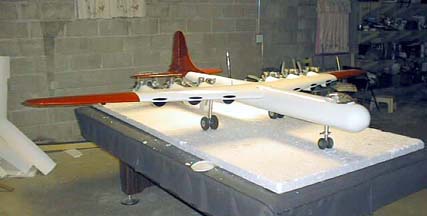 Will
Shea's B-36B model has a 113" wingspan and is powered by
.46abc engines.
Will
Shea's B-36B model has a 113" wingspan and is powered by
.46abc engines.
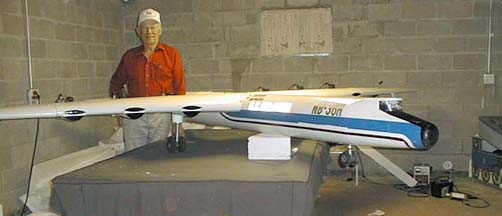 Will
Shea's even bigger NB-36H model has a 210" wingspan. It is
powered by six G-23 engines and was featured in the Oct. 2001
issue of RCM Magazine.
Will
Shea's even bigger NB-36H model has a 210" wingspan. It is
powered by six G-23 engines and was featured in the Oct. 2001
issue of RCM Magazine.
Proposed Oversize B-36 Cargo Conversion |
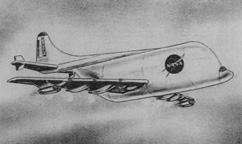 In 1964, Fairchild Stratos Corporation proposed a modification of
the B-36 Peacemaker for transporting the second stage of the
Saturn V, much the way Conroy modified the Boeing Stratocruiser
into the Pregnant Guppy to carry the
third stage of the giant rocket.
In 1964, Fairchild Stratos Corporation proposed a modification of
the B-36 Peacemaker for transporting the second stage of the
Saturn V, much the way Conroy modified the Boeing Stratocruiser
into the Pregnant Guppy to carry the
third stage of the giant rocket.
eBook editions of Flying Aircraft Carriers of the USAF |
||
|
My books in the Flying Aircraft Carriers of the USAF series are now available as eBooks, at a considerably reduced price compared to the print editions. Following World War II, the US Air Force was faced with the need to extend the range of fighter escorts for bomber airplanes. Several programs explored the feasibility of carrying, launching, and retrieving jet fighters from Convair B-36 bombers. In 1948 and 1949, the Air Force tested the McDonnell XF-85 Goblin, which was intended to fit inside the bomb bay of the B-36, in a series of launches from a modified Boeing B-29 Superfortress. From 1949 to 1956, the Air Force explored wing tip coupling, attaching smaller airplanes to the wing tips of larger airplanes, first with a Culver PQ-14 coupled to a Douglas C-47 Skytrain, then with a pair of Republic F-84E Thunderjets coupled to a Boeing B-29 Superfortress, and concluding with tests of Republic RF-84F Thunderflashes coupled to the wing tip of a Convair B-36. From 1952 to 1956, Project FICON (Fighter Conveyer) evaluated carrying Republic F-84s partially enclosed in the bomb bay of a B-36, concluding with the establishment of squadrons of modified Republic RF-84F Thunderflashes and Convair B-36s in Washington State. Each volume is profusely illustrated with vintage photographs and diagrams. They can be dowloaded directly from Lulu.com. |
||
|
Flying Aircraft Carriers of the USAF: McDonnell XF-85 Goblin
|
Flying Aircraft Carriers of the USAF: Wing Tip Coupling
|
|
LockettBooks Bookshelf |
|||
BooksMy books are printed on demand by Lulu.com. When you select one, it is placed in your Lulu.com shopping cart. When you place your order, the items are produced, packaged, and shipped directly to you. Books are 8.5" x 11" with perfect binding, white interior paper (60# weight), white exterior paper (100# weight), and full-color exterior ink. |
|||
|
Flying Aircraft Carriers of the USAF: Project FICON Preview the first several pages of the paperback book. Flying Aircraft Carriers of the USAF: Project FICON |
Flying Aircraft Carriers of the USAF: Wing Tip Coupling |
||
|
Project FICON Handbooks |
|||
You can buy a 2020 calendar featuring historic Air Force and Convair photographs of Project FICON Convair GRB-36 carrier aircraft and Republic F-84 parasites.
A dozen Air Force and Convair photographs of Project FICON Convair GRB-36 carrier aircraft and Republic F-84 parasites from 1952 to 1956:
Convair GRB-36F 49-2707 and Republic F-84E Thunderjet 49-2115 at Forth Worth, Texas and Eglin Air Force Base, Florida
Convair GRB-36F 49-2707 and Republic YRF-84F Thunderstreak 49-2430 at Fort Worth, Texas and Dayton, Ohio
Convair GRB-36D 49-2962 and Republic RBF-84F Thunderflash 52-7266 over Washington State
Convair GRB-36D 49-2694 and Republic RF-84K Thunderflash 52-7258 at Edwards Air Force Base, California
 Put a copy of the Project FICON - Fighter Conveyer: 2020 calendar in your Lulu.com shopping cart for $14.95.
Put a copy of the Project FICON - Fighter Conveyer: 2020 calendar in your Lulu.com shopping cart for $14.95.
You can buy a 2020 calendar featuring photographs of Air Force projects investigating the coupling of smaller airplanes to larger airplanes' wing tips.
In the early years of the cold war, the US Air Force attempted to increase the range of airplanes by carrying fuel in hinged wing panels that supported themselves attached to their wing tips. The initial tests used a piloted light plane to simulate the hinged panels. Soon the scope of the experiments expanded to include towing a pair of jet fighters on the wing tips of a giant bomber. Photo sources: Bud Anderson, Air Force, General Dynamics, Lockheed-Martin:
Douglas C-47A 42-23918 and Culver Q-14B 44-68334
Project Tip-Tow: Boeing EB-29A 44-62093 and Republic EF-84D Thunderjets 48-0641 and 48-0661
Project Long Tom: Beechcraft XL-23C
Project Tom-Tom: Convair JRB-36F 49-2707 and Republic RF-84F Thunderflashes 51-1848 and 51-1849
 Put a copy of the Wing Tip Coupling: 2020 calendar in your Lulu.com shopping cart for $14.95.
Put a copy of the Wing Tip Coupling: 2020 calendar in your Lulu.com shopping cart for $14.95.
Giant Airplanes of the 1940s |
||||||
| First Flight | Wing Span | Length | Wing Area | Gross Weight | Engines | |
| Bristol Brabazon | 1949 |
230ft,00in |
177ft,00in |
5,317 |
290,000 |
8 x 2,650hp Bristol Centaurus |
| Hughes Flying Boat (Spruce Goose) | 1947 |
320ft,00in |
218ft,06in |
11,430 |
300,000 |
8 x 3,500hp R4360 |
| Convair XC-99 | 1947 |
230ft,00in |
185ft,00in |
4,772 |
320,000 |
6 x 3,500hp R4360 |
| Northrop YB-49 Flying Wing | 1947 |
172ft,00in |
53ft,01in |
4,000 |
194,000 |
8 x 3,700 lb J-35 |
| Convair B-36 | 1946 |
230ft,00in |
162ft,01in |
4,772 |
370,000 |
6 x 3,500hp R4360, 4 x 5,200 lb J-47 |
| Lockheed R6V Constitution | 1946 |
189ft,01in |
156ft,01in |
3,610 |
184,000 |
4 x 3,000hp R4360 |
| Douglas DC-6 | 1946 |
117ft,06in |
100ft,07in |
1,463 |
97,200 |
4 x 2,100 hp R2800 |
| Douglas C-74 Globemaster | 1945 |
173ft,03in |
124ft,02in |
2,506 |
145,000 |
4 x 3,000hp R4360 |
| Blohm und Voss BV-238 | 1945 |
197ft,05in |
142ft,8in |
3,930 |
176,400 |
6 x BMW 801 |
| Boeing 367 Stratocruiser | 1944 |
141ft,03in |
110ft,04in |
1,738 |
120,000 |
4 x 3,000hp R4360 |
| Lockheed 049 Constellation | 1943 |
123ft,00in |
95ft,02in |
1,650 |
86,200 |
4 x 2,000 hp R3350 |
| Martin JRM Mars | 1942 |
200ft,00in |
117ft,00in |
3,683 |
144,000 |
4 x 2,000 hp R3350 |
| Douglas DC-4 | 1942 |
117ft,06in |
93ft,10in |
1,460 |
73,000 |
4 x 1,350 hp R2000 |
| Douglas XB-19 | 1941 |
212ft,00in |
132ft,00in |
4,492 |
164,000 |
4 x 2,000 hp R3350 |
| Tupolev Ant-20bis | 1940 |
206ft,08in |
111ft,11in |
5,231 |
99,200 |
6 x 1,200 hp M-34FRNV |
| Blohm und Voss BV-222 | 1940 |
150ft,11in |
120ft |
2,744 |
108,000 |
6 x 1,000 hp BMW-Bramo Fafnir 323R |
Books about the Convair B-36 from Amazon.com |
||||||
Visit the Lockett Books Amazon Webstore for a selection of aviation and space related books and DVDs. |
||||||
 The history of the efforts to preserve B-36J, 52-22827 at Fort Worth is well documented in "B-36: Saving the Last Peacemaker"; Second Edition, an html book on CD. This CD-ROM is viewed with your internet browser.
The history of the efforts to preserve B-36J, 52-22827 at Fort Worth is well documented in "B-36: Saving the Last Peacemaker"; Second Edition, an html book on CD. This CD-ROM is viewed with your internet browser.
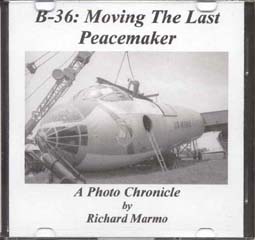 B-36: Moving the Last Peacemaker. These 875 photos show photographically the effort expended by all of the volunteers over a nine year period to save the aircraft. This CD-ROM is a self contained slide show that does not require a browser to view.
B-36: Moving the Last Peacemaker. These 875 photos show photographically the effort expended by all of the volunteers over a nine year period to save the aircraft. This CD-ROM is a self contained slide show that does not require a browser to view.
 Go
to the main Convair B-36 page.
Go
to the main Convair B-36 page.
Go to home page of the Goleta Air and Space Museum.
Send a message to Brian.